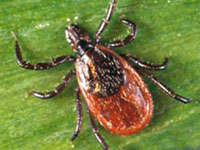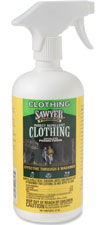 Ticks are always a concern in the outdoors because they can carry bacteria that cause Lyme disease, Rocky Mountain spotted fever and a host of lesser-known viruses, like ehrlichiosis and anaplasmosis. Although tick-borne diseases tend to concentrate in the western, southern and eastern states, the problem is rearing its ugly head this year in the upper Midwest and southern Canada. A Minnesota child recently died from Rocky Mountain spotted fever.
Ticks are always a concern in the outdoors because they can carry bacteria that cause Lyme disease, Rocky Mountain spotted fever and a host of lesser-known viruses, like ehrlichiosis and anaplasmosis. Although tick-borne diseases tend to concentrate in the western, southern and eastern states, the problem is rearing its ugly head this year in the upper Midwest and southern Canada. A Minnesota child recently died from Rocky Mountain spotted fever.
If ticks are a potential problem in the area that you are planning to camp, there are some proactive steps you can take to protect your family. Ticks are most commonly found on bushes and tall grass, where a passing animal is likely to brush-up against them. Sticking open spaces, like the middle of a trail, is your best defense against ticks. This includes setting-up your tent away from bushes, tall grass and overhanging branches that could provide ticks access to your shelter and your family.
 Clothing can be another line of defense against ticks. Although I prefer to hike in shorts, if I am hiking in a potentially tick-infested area, it pays to cover as much skin as possible and that means hiking in pants. Khaki colored pants are even better, since the dark-colored ticks will be easier to spot. Make sure to give everyone in the family a thorough tick-check during water and snack breaks, particularly around the waistline. A good practice is to tuck pants into socks and spray the pant legs, socks and boots with a permethrin product, like Sawyer’s. Permethrin lasts much longer on clothes than DEET, but it should only be used on clothing and not directly on skin.
Clothing can be another line of defense against ticks. Although I prefer to hike in shorts, if I am hiking in a potentially tick-infested area, it pays to cover as much skin as possible and that means hiking in pants. Khaki colored pants are even better, since the dark-colored ticks will be easier to spot. Make sure to give everyone in the family a thorough tick-check during water and snack breaks, particularly around the waistline. A good practice is to tuck pants into socks and spray the pant legs, socks and boots with a permethrin product, like Sawyer’s. Permethrin lasts much longer on clothes than DEET, but it should only be used on clothing and not directly on skin.
If you routinely camp or travel outdoors in tick-infested areas, you can plan finding a tick on your body, at some point. This is not a cause for panic; a tick has to be attached to your body for 24 to 48 hours in order to transmit a disease. It needs to be removed as soon as you find it, though, so this means carrying tweezers and antiseptic with you on hikes. Tweezers are the only recommended method of removing ticks, so forget the old practices of burning or smothering with nail polish. The Center for Disease Control has a very good page on tick removal here.
See also…

We have plenty of ticks around depending on where you go. Funny, I’ve never been bitten by one despite having found them on me hours later…
Jim – good point, did that happen in New York? I think all of the people I’ve met with Lyme disease were from the northeast – strange.
If you camp with your dog don’t forget to protect the pooch too… Ask your vet about the lyme disease vaccination, Also there are many topical tick repellent meds that you can get form your vet.
My dog Max tested positive for lyme this past Friday, lyme disease effects the joints and Saturday he was unable to stand on his own. It was so sad to see him this way. Something that could have been prevented so easily… Don’t worry Max is doing much better now that he is on his meds…